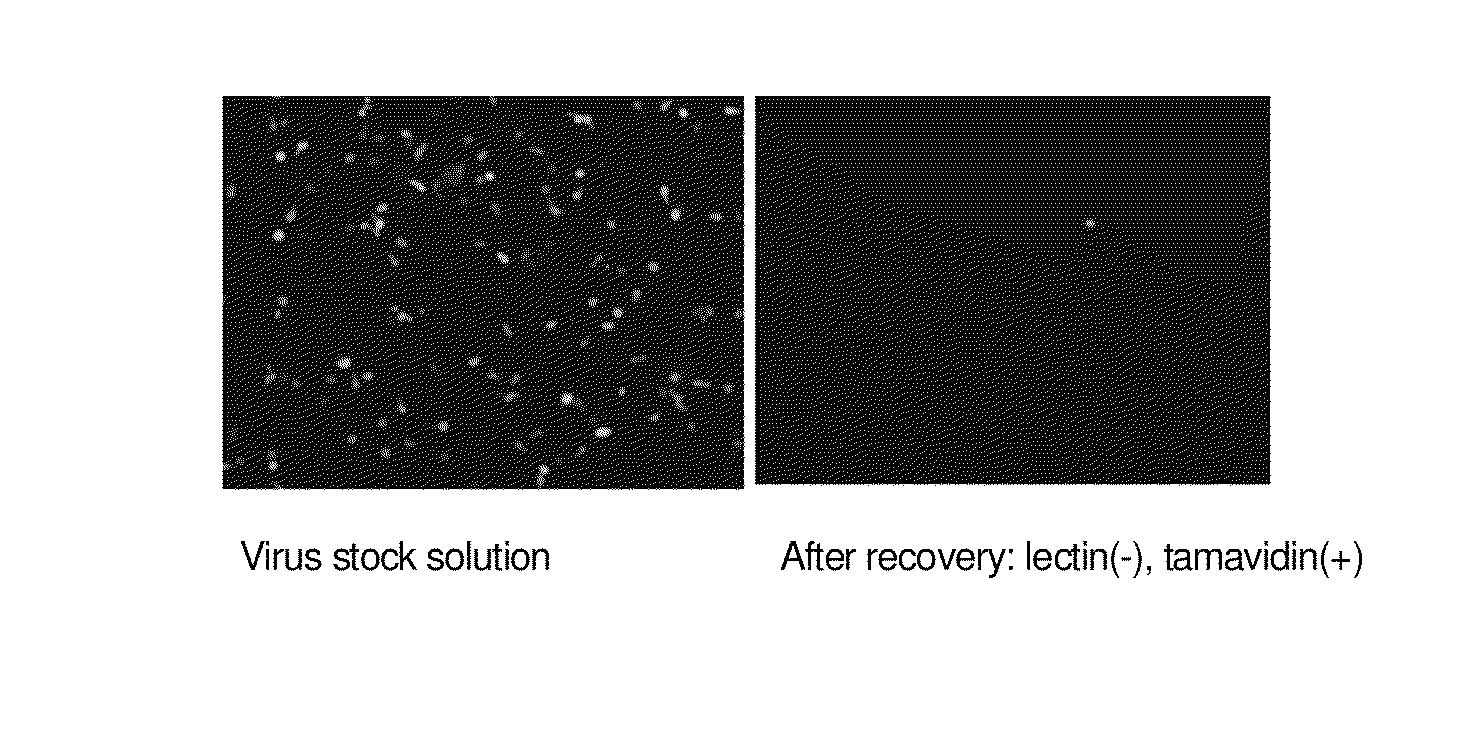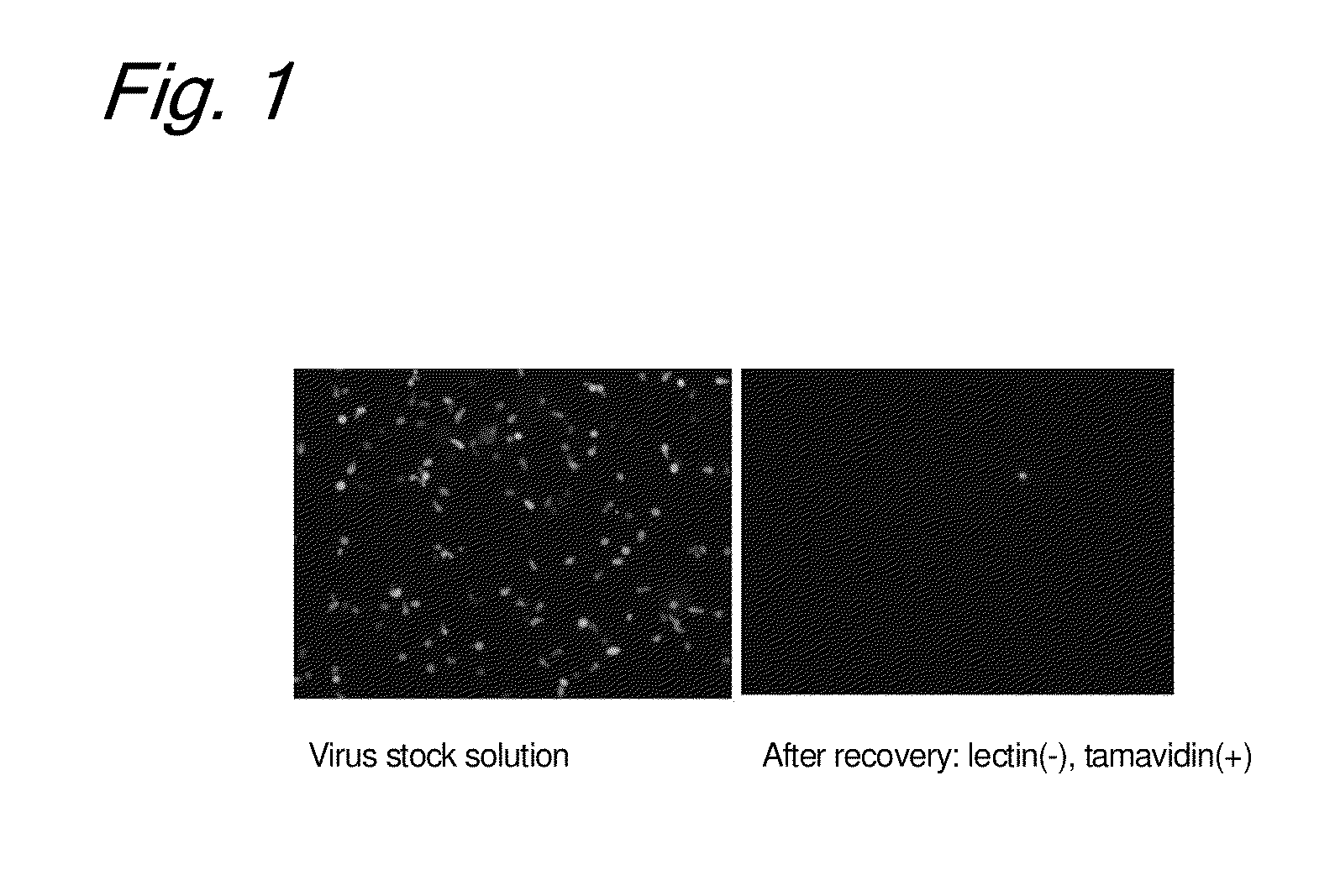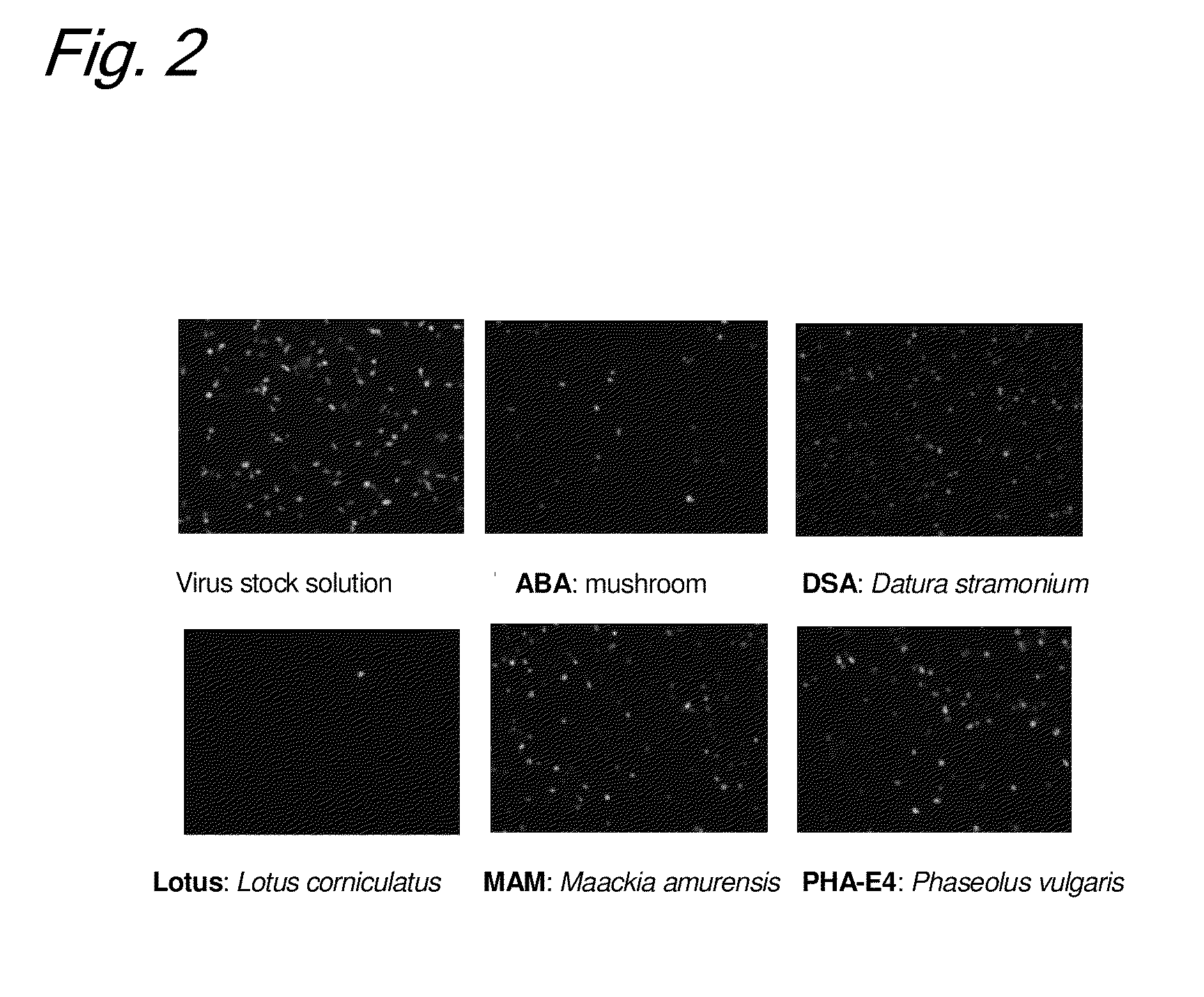Enrichment method of virus
a virus and enrichment technology, applied in the field of enrichment methods of viruses, can solve the problems of insufficient efficiency of gene introduction, insufficient desirable effects, and various practical problems, and achieve the effect of concentrating readily and maintaining the ability to in
- Summary
- Abstract
- Description
- Claims
- Application Information
AI Technical Summary
Benefits of technology
Problems solved by technology
Method used
Image
Examples
example 1
Screening of Lectin that can Concentrate HHV-6
[0154]Enrichment of HHV-6 was investigated by allowing 15 biotinylated lectins (Con A, DBA, LCA, PHA-E4, PNA, RCA120, UEA-I, WGA, ABA, DSA, Lotus, MAM, PHA-L4, SBA, and SSA) to react with a cultured HHV-6 in solution and then to bind to tamavidin-immobilized magnetic beads.
[0155]1. Preparation of HHV-6 Solution from Cultured T Cells
[0156]Cultured human cord blood-derived T cells were infected with recombinant HHV-6 expressing EGFP (Japanese Patent No. 3923505) to produce an EGFP-type HHV-6 solution.
[0157]2. Preparation of Tamavidin Magnetic Beads
[0158]Magnetic beads (300 μL) having surfaces coated with carboxyl groups (available from Dynabeads M-270 Carboxylic Acid, Dynal Inc.) were washed with 0.01 N sodium hydroxide (300 μL) for 10 min and then with ultrapure water (300 μL) for 10 min three times. To the washed magnetic beads, 1-ethyl-3-(3-dimethylaminopropyl)carbodiimide hydrochloride (EDC) (Pierce Inc.) dissolved in cooled ultrapure ...
example 2
Enrichment of HHV-6 in Saliva
[0167]Enrichment of HHV-6 in saliva was tried using lectinylated biotin and tamavidin magnetic beads.
[0168]1. Collection of Saliva
[0169]Saliva was collected from a subject with Salivette (Salivette cotton, Sarstedt). The subject rinsed the oral cavity with distilled water twice immediately before the collection of saliva and put the inner cotton of the Salivette in the oral cavity to collect saliva for 2 min.
[0170]2. Quantitative Determination of HHV-6
[0171]First, the concentration of HHV-6 in the saliva was measured.
[0172]HHV-6 DNA in 400 μL of the saliva collected in Section 1 above was purified using BioRobot EZ1 (Qiagen Inc.) and EZ1 Virus Mini Kit v2.0 (Qiagen Inc.) in accordance with the protocol of EZ1 Virus Mini Handbook (Qiagen Inc.).
[0173]The resulting DNA was subjected to quantitative PCR. In the quantitative PCR, the HHV-6 U65 / 66 region was quantitatively determined by real-time PCR. The sequences used in the PCR were as follows:
(SEQ ID NO: 1...
example 3
Enrichment of Lentiviral Vector Using Lectin
[0182](1) Enrichment
[0183]A lentiviral vector having a HIV-based gene and VSV-G envelope, which is recombined with EGFP gene, were used as a lentivirus (obtained from Dr. Hiroyuki Miyoshi, Riken). The biotinylated lectins used were the following 15 types: (Con A, DBA, LCA, PHA-E4, PNA, RCA120, UEA-I, WGA, ABA, DSA, Lotus, MAM, PHA-L4, SBA, and SSA) manufactured by J-Oil Mills Inc.
[0184]First, 100 μL of an EGFP recombinant lentivirus solution (virus concentration: 102 particles / ml TE, note that a low-titer virus was used for investigating enrichment effect) was mixed with 500 μL of PBS and 10 μg of a biotinylated lectin, followed by incubation at 15° C. for 1 h (upside-down mixing). Then, the tamavidin magnetic beads prepared in Example 1 were added to the reaction solution, followed by further incubation at 15° C. for 1 h (upside-down mixing). Then, the Eppendorf tube containing the reaction solution was placed in a magnetic stand for Dyna...
PUM
| Property | Measurement | Unit |
|---|---|---|
| diameter | aaaaa | aaaaa |
| pH | aaaaa | aaaaa |
| spherical diameter | aaaaa | aaaaa |
Abstract
Description
Claims
Application Information
 Login to View More
Login to View More - R&D
- Intellectual Property
- Life Sciences
- Materials
- Tech Scout
- Unparalleled Data Quality
- Higher Quality Content
- 60% Fewer Hallucinations
Browse by: Latest US Patents, China's latest patents, Technical Efficacy Thesaurus, Application Domain, Technology Topic, Popular Technical Reports.
© 2025 PatSnap. All rights reserved.Legal|Privacy policy|Modern Slavery Act Transparency Statement|Sitemap|About US| Contact US: help@patsnap.com



